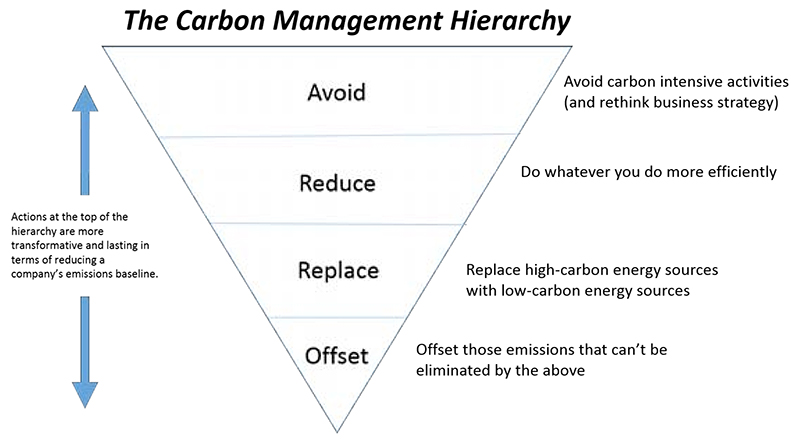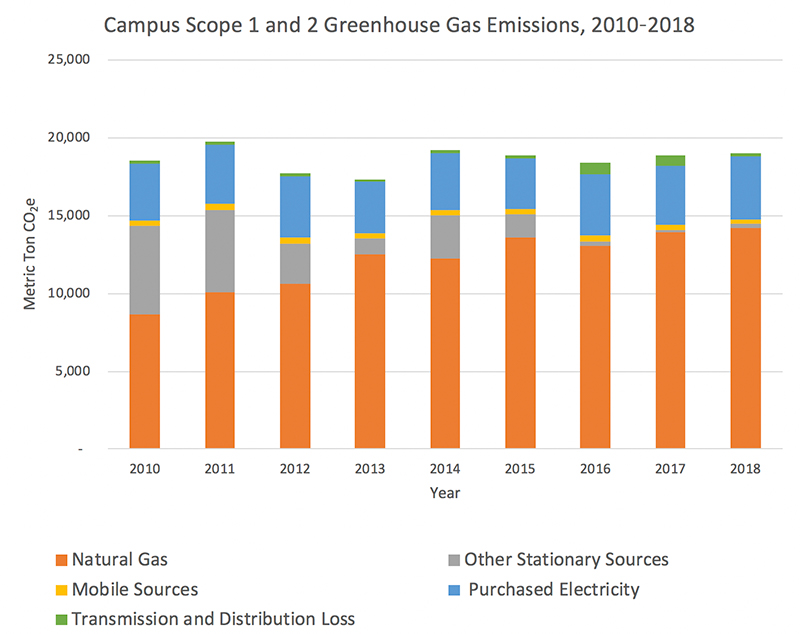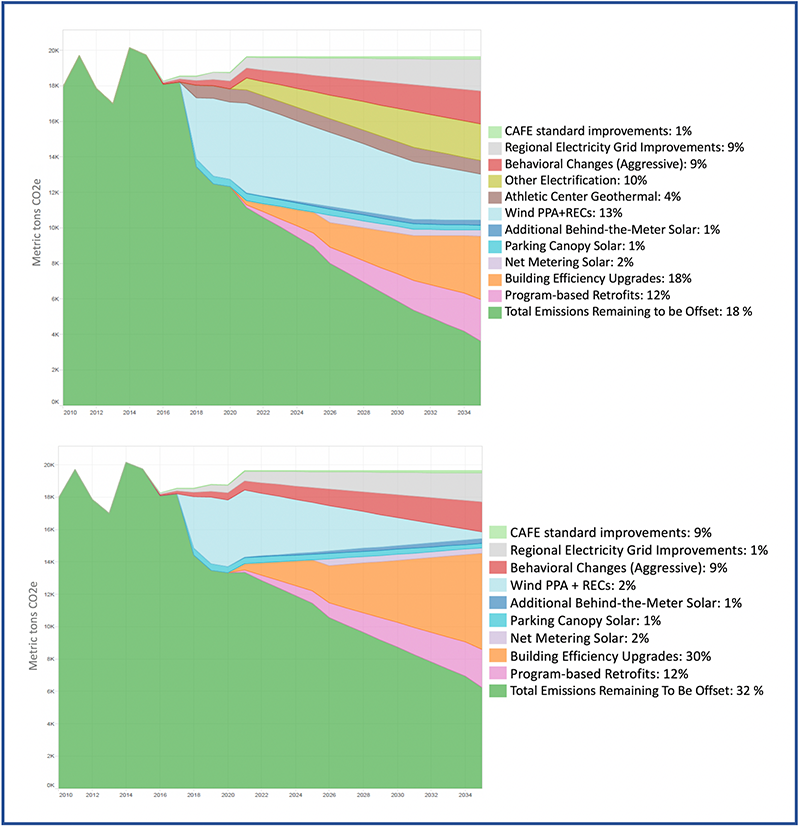The Climate Action Task Force
This document details the Climate Action Plan developed by the Climate Action Task Force starting in March 2015. The task force was led by Laura Draucker, director of sustainability. Task force members included Jim Brassord, chief of campus operations ; Brian Beaty ’17; Alexzandria Chalmers ’17; Suzanne Coffey, then chief student affairs officer; Tom Davies, director of design and construction/facilities; David Jones, associate professor of geology; Emy Kelty ’16; Rachel Levin, senior lecturer in biology and environmental studies; Alena Marovitz ’17; Anna Martini, professor of geology and environmental studies; Edward (Ted) Melillo, associate professor of history and environmental studies; Kevin Weinman, chief financial officer; and Peter Woolverton ’17.
Climate Action Plan Guiding Principles
The task force began meeting in March 2015, and its first output was a set of principles that would guide the development of the Climate Action Plan. These principles underpin the overarching goal of the plan to have a meaningful and lasting impact on greenhouse gas reduction and management at Amherst College and beyond, supporting the urgent global need to combat climate change.
These principles, detailed below in alphabetical order, are of equal importance and are not mutually exclusive. During the development of the plan, specific decisions were made that required some principles to be prioritized. However, when considered holistically, the plan strives for a balanced approach, with consistent application of all principles.
The Climate Action Plan will be…
Collaborative: The Amherst College community will be conscious of our role as good neighbors in the Town of Amherst and beyond. We will work collaboratively as a campus, as a Five College Consortium member institution, as Massachusetts residents and as global citizens to learn from each other and collaborate when feasible.
Conservation-Focused: We will prioritize projects and solutions that support real and effective reductions in our emissions.
Dynamic and Timely: As technology, behavior, emission profiles and many other influencing factors change, so must the plan and its implementation, in order to stay relevant and actionable to the larger goal of addressing climate change. We must have plans and timelines in place to review and update our path forward with this larger goal, and our guiding principles, in mind. We must also consider the urgency of climate change, and that actions now are more valuable than actions in the future.
Financially Viable: The plan will be developed with financial sustainability in mind, both for immediate priorities and into the future. This will ensure its implementation remains steadfast even in times of economic constraint.
Mission-Driven: The mission of Amherst College is to educate students “of exceptional potential from all backgrounds so that they may seek, value and advance knowledge, engage the world around them, and lead principled lives of consequence.” To support this, the plan must not live in a silo of operational improvements hidden to passersby; instead it must incorporate and support communication, engagement and educational opportunities throughout its implementation, highlighting successes and collaborating on challenges. Additionally, we need to consider the evolution of “lives of consequence” as we mitigate greenhouse gas emissions and adapt to a world impacted by climate change.
Scalable: Greenhouse gas reductions achieved by Amherst College will be insignificant when compared to the global reductions needed to stay below a 1.5-degree temperature increase. By experimenting with novel approaches to reductions and sharing them with the world, we can scale our impact exponentially. Priority will be given to solutions that have this potential.
Transparent: The development of this plan, its implementation and any future updates will be done in a transparent way that seeks the input of all interested and impacted stakeholders.
Development Approach
Quantifying greenhouse gas (GHG) emission inventories and setting reduction goals started at the national level in the 1990s, with the formation of the UNFCCC and the first guidelines for inventory development by the IPCC in 1996.7 Corporate entities followed suit, calling for their own standards for accounting and reporting GHG emissions in the late 1990s.8 In 2006, 12 college and university presidents were “motivated by their conviction that higher education had the capacity and responsibility to lead on climate and sustainability action for the sake of their students and society” to form the American College & University Presidents’ Climate Commitment.9 Over the next 11 years, more than 600 institutions joined to commit themselves to a goal of carbon neutrality. This time period saw the formation of many higher-education sustainability offices and the development of many climate action plans.
GHG reduction strategies—whether at the national, corporate or higher-education level—have typically followed the “carbon management hierarchy” approach. This approach meets GHG reduction goals by focusing first on avoiding carbon-intensive activities, then reducing emissions through efficiency improvements and replacing high-carbon sources with renewables or other low-carbon alternatives, and finally offsetting any remaining GHG emissions. When you can no longer reduce your own emissions, carbon offsets are a type of purchased "credit" that allows you to purchase and then claim emission reductions that are occurring somewhere else. A common example occurs when you book a plane ticket: the airline may ask if you want to offset the emissions caused by your flight by contributing money in a value equivalent to those emissions to reforestation in the Amazon rainforest.
8 http://www.ghgprotocol.org/about-us
9 http://secondnature.org/who-we-are/background/

Figure 1: The Carbon Management Hierarchy (To learn more, view The State of Sustainability in Higher Education.)
As the task force began its work, we too looked first to the carbon management hierarchy approach to help inform our carbon neutrality plan. We started with an inventory of our current emission sources, which identified our focus areas. Typical GHG inventories include different emission scopes: scope 1 includes emissions directly under our operational control, scope 2 includes emissions associated with purchased electricity and steam, and scope 3 includes emissions that occur within our supply chain, such as waste treatment and food procurement. At this time, we have only addressed scope 1 and scope 2 emissions in our GHG inventory and Climate Action Plan. We currently address scope 3 emissions through other initiatives, such as waste reduction projects and lower-carbon food procurement strategies and in the future may consider quantifying these as scope 3 categories.
Figure 2 shows the breakdown of our GHG emissions since 2010, the baseline determined by the task force. Our largest emission source is the combustion of fuels in stationary sources, and specifically natural gas, to create steam and electricity for campus. While this is done with an energy-efficient combined heat and power (CHP) system, it still creates significant greenhouse gas emissions. Other stationary-source emissions include oil and propane used in lieu of natural gas in the central power plant or for small boiler systems around campus. Mobile sources include gas and diesel used by the campus-owned vehicle fleet. Purchased electricity is the electricity we use from the grid, and transmissions and distribution loss account for the inefficiencies in grid transmission.

Figure 2: Campus Scope 1 and 2 Greenhouse Gas Emissions (Metric Tons CO2e) Over Time by Source, 2010–2018
Once our emission sources were identified, we hired a consultant—Competitive Energy Services (CES)—to help us determine reduction pathways in the form of a wedge chart. A wedge chart is a useful tool to determine, as indicated in the carbon management hierarchy, which emissions can be avoided, reduced and replaced. CES developed wedge charts (Figure 3) for two different scenarios: one where we maximize conservation efforts on campus toward an “island model” where we can meet our energy needs through our existing power plant alone, and another where we maximize the use of renewable energy under our current energy infrastructure.

Figure 3: Wedge charts created to show two potential reduction pathways. Top: Maximizing Conservation. Bottom: Maximizing Renewables.
The wedge chart analysis revealed many things, the most important of which was that even with aggressive reduction assumptions, we would not be able to achieve carbon neutrality using our current energy infrastructure without offsets. Deeper dives on each of these reduction options, considering cost and impact, would be needed to have more confidence in our reduction potential, and those analyses themselves would be costly. Therefore, a goal set on this analysis would be based on very high-level assumptions of reduction potential that could quickly prove difficult, less impactful that estimated or cost-prohibitive.
It became clear to us why the carbon management hierarchy approach can lead toward what the task force termed “offset complacency.” Because offsets have historically been a relatively cheap way to reach neutrality, institutions end up relying on offsets for a larger portion of their GHG emission reduction goals than initially planned, particularly when on-campus reduction projects become more complex and costly than originally assumed. While the task force did not rule out the use of offsets for some emissions that may not be possible to reduce to zero (e.g., fuel combustion by heavy-duty trucks unable to run on renewable electricity), they were clear that conservation should be a guiding priority of the plan, and they held reservations about the effectiveness of offsets in actually reducing global GHG emissions. This is a debated topic that will not be discussed here, but may be researched in more detail as the Climate Action Plan implementation process proceeds.
We concluded that we needed to rethink our approach to carbon neutrality. Around the same time, Stanford University announced a radical shift to their campus energy system: they would decommission its co-generation facility and invest significantly in a heat recovery system and renewable energy.10 We questioned whether such a system could work in the New England climate, but we discovered that, while the specific technology Stanford used would not work for Amherst, the overarching idea—moving away from steam to low-temperature hot water that can be powered by renewable resources—is something other institutions had started to embrace, even in climates similar to our own. After Smith College11 did an initial assessment and determined that an energy system transformation would be feasible on their campus, Amherst focused on moving away from incremental reduction projects toward removing the source of the majority of our emissions: combustion of fossil fuel to heat, cool and power our campus. This, combined with our focus on connecting the technical work to the educational experience for our students, led us toward the two main pillars of our Climate Action Plan: decarbonization of our campus energy system and experiential education opportunities.
10 https://news.stanford.edu/features/2015/sesi/
11 https://www.smith.edu/sites/default/files/media/Documents/Sustainability/decarbonization_study.pdf